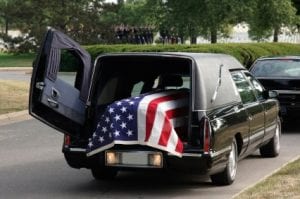Driving in Funeral Processions and What to Do When You Encounter One

If you will not be driving in the procession, the funeral attendants will direct you to park in another area.
Top 5 Things to Know About Driving in a Funeral Procession
- You will be driving very slowly – usually 30-40 mph on roads, depending on the normal speed limit, and no more than 55 mph on the highway.
- You will need to stay close to the car in front of you in the procession – do not allow room for a vehicle not in the procession to cut in.
- Stay in line and with the procession at all times – even if means you are going through a red light at an intersection. Local traffic ordinances give a funeral procession the right-of-way, and other motorists must yield until the procession has passed. Do not leave your place in the procession line unless there is an emergency.
- The last car in the procession will have 2 funeral flags and will also have hazards lights flashing to signify to other motorists that the procession has ended and that traffic may resume.
- Once you arrive at the cemetery, a cemetery attendant will lead the procession to the gravesite or chapel, and the funeral attendant will collect the flags from your vehicle.
Immediate family members may be riding in a limousine. But if you are family or a close friend and will be driving your own vehicle in the procession, you should arrive at the funeral home or church about 45 minutes prior to the funeral to ensure that you are parked near the front of the procession. All others will be parked in the order in which they arrive.
The funeral attendant typically places a magnetic flag, usually bright orange in color, that reads “Funeral” on the car. The flag is placed on the hood of the vehicle in the front left corner, over the driver’s side. If there are many cars in the procession, the attendant may place the flag on every other vehicle or every 3rd vehicle. You will also be instructed to turn your headlights on for the drive to the cemetery. Both the funeral flags and the headlights signifies to other motorists that you are part of a funeral procession.
When the funeral service is over, the pallbearers will transport the casket outside and place it in the hearse. A funeral attendant should direct you to get in your vehicle and be ready to follow those ahead of you in the procession line.
The procession is typically led by a black sedan (known as the “lead car”) bearing white funeral flags with hazard lights flashing – this lets other motorists know that a funeral procession is moving through traffic. Following the sedan is the hearse, and then the family limousines, and then all the vehicles of those driving in the procession.
What To Do When You Encounter a Funeral Procession
Just remember that funeral processions have the right-of-way. Here are some additional Do’s and Don’ts on how to handle a funeral procession that passes through an area where you are driving:
- Do be respectful.
- Do yield – once the lead car has entered traffic, such as going through an intersection – the entire procession will follow without interruption. Even if their traffic light is red and yours is green, you must stop and allow the procession to continue through the intersection until all cars in the procession have passed.
- Do look for the last vehicle in the procession – it typically has 2 or more flags and hazard lights flashing. Once it passes by, you may resume the normal flow of traffic.
- Don’t cut into or cut off a procession.
- Don’t honk at a car in a funeral procession.
- Don’t pass a funeral procession on the right side on a highway, unless the procession is in the far left lane.
Vehicle Choices for the Funeral Procession
Funeral homes and other service providers offer various types of vehicles to transport the deceased and the family during the course of a funeral. They are:
- Funeral Coach – Also known as a hearse, a funeral coach is the traditional choice for transporting the casket in processions between service locations and to the cemetery. Because of the room required for the casket, there is no additional seating in this vehicle for anyone other than the driver and the funeral director.
- Limousine – These are elegant vehicles that are typically used to transport family members in funeral processions.
- Funeral Service Vehicles – These may include sedans or vans that are generally less expensive options to using a funeral coach and limousine. Service vehicles are also used.